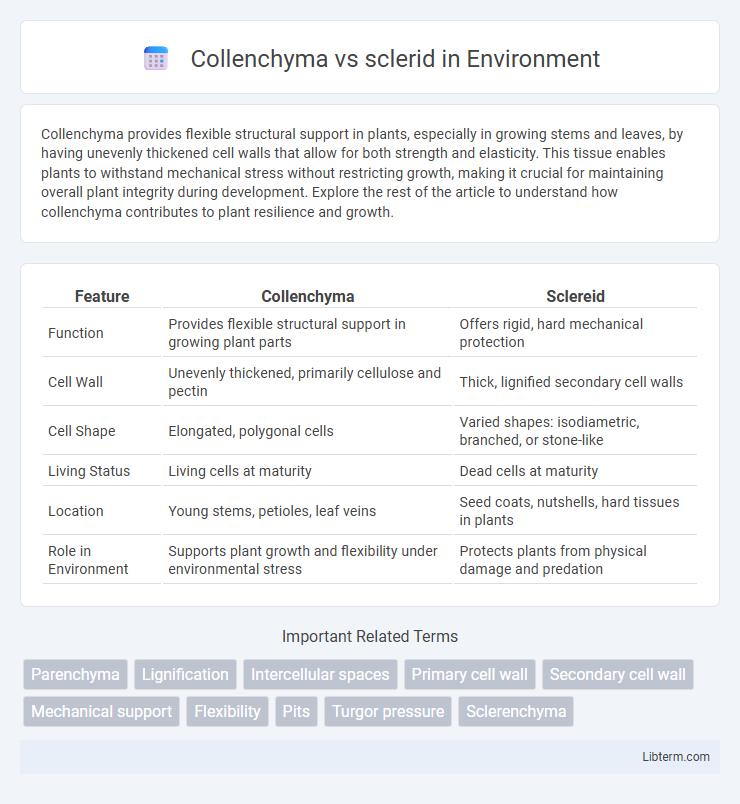Collenchyma provides flexible structural support in plants, especially in growing stems and leaves, by having unevenly thickened cell walls that allow for both strength and elasticity. This tissue enables plants to withstand mechanical stress without restricting growth, making it crucial for maintaining overall plant integrity during development. Explore the rest of the article to understand how collenchyma contributes to plant resilience and growth.
Table of Comparison
| Feature | Collenchyma | Sclereid |
|---|---|---|
| Function | Provides flexible structural support in growing plant parts | Offers rigid, hard mechanical protection |
| Cell Wall | Unevenly thickened, primarily cellulose and pectin | Thick, lignified secondary cell walls |
| Cell Shape | Elongated, polygonal cells | Varied shapes: isodiametric, branched, or stone-like |
| Living Status | Living cells at maturity | Dead cells at maturity |
| Location | Young stems, petioles, leaf veins | Seed coats, nutshells, hard tissues in plants |
| Role in Environment | Supports plant growth and flexibility under environmental stress | Protects plants from physical damage and predation |
Introduction to Plant Support Tissues
Collenchyma cells provide flexible, mechanical support to growing plant tissues, characterized by unevenly thickened primary walls that allow for elasticity and growth. Sclereids, a type of sclerenchyma cell, offer rigid support through thick, lignified secondary walls that strengthen mature plant parts like seed coats and nutshells. Both tissue types contribute to plant structure, with collenchyma supporting elongation and sclereids enhancing durability and protection.
Definition of Collenchyma
Collenchyma is a type of plant tissue characterized by elongated cells with unevenly thickened primary walls, providing flexible structural support in growing shoots and leaves. It differs from sclereids, which are shorter, lignified cells with thick secondary walls that contribute to the hardness and rigidity of mature plant tissues. Collenchyma cells remain alive at maturity, enabling flexibility, whereas sclereids typically form part of protective tissues.
Definition of Sclerids
Sclereids are a type of sclerenchyma cell known for their thick, lignified secondary walls that provide structural support and protection in plants. Unlike collenchyma cells, which have unevenly thickened primary walls and primarily offer flexible support in young tissues, sclereids are rigid and contribute to the hardness of seed coats, nutshells, and gritty textures in fruits. These cells are typically dead at maturity, forming dense, protective layers that strengthen plant organs.
Key Structural Differences
Collenchyma cells have thickened primary cell walls that provide flexible support primarily in growing parts of plants, whereas sclereids possess thick, lignified secondary walls contributing to rigidity and protection. Collenchyma tissues display uneven wall thickening, often in corners of cells, allowing elasticity, while sclereids are more uniformly thickened with a stone-like hardness. Unlike the living, metabolically active collenchyma cells, sclereids are typically dead at maturity, forming durable structures like seed coats and nutshells.
Cell Wall Composition
Collenchyma cells have unevenly thickened primary cell walls composed mainly of cellulose and pectin, providing flexible support in growing plant tissues. Sclereids possess thick, lignified secondary cell walls enriched with lignin, making them rigid and protective in mature plant structures. The key difference in cell wall composition is that collenchyma walls remain non-lignified and pliable, while sclereid walls are heavily lignified and hardened.
Location in Plant Organs
Collenchyma cells are primarily located beneath the epidermis in stems, petioles, and leaf veins, providing flexible support to growing regions. Sclereids, a type of sclerenchyma cells, are found throughout various plant tissues, including seed coats, nutshells, and fruit pits, contributing to hardness and protection. Unlike the more localized collenchyma, sclereids are dispersed widely in both primary and secondary plant organs.
Functions and Roles
Collenchyma provides flexible structural support in growing plant tissues, allowing for elasticity and strength without restricting growth, crucial for young stems and leaves. Sclereids contribute to mechanical protection and hardness in mature plant parts, enhancing resistance against herbivory and physical damage through their thick, lignified cell walls. Together, these cells optimize plant durability by balancing flexibility and rigidity in different developmental stages.
Types and Variations
Collenchyma cells exhibit various types such as angular, lamellar, and lacunar, each distinguished by differing wall thickening patterns that provide flexible support to growing plant organs. Sclereids, a type of sclerenchyma, include several variations like brachy-sclereids, macrosclereids, and astrosclereids, characterized by thick, lignified walls that contribute to hardness and protection in plant tissues. The structural diversity between collenchyma and sclereid types reflects their specialized roles in plant mechanics and defense.
Developmental Origins
Collenchyma cells originate from the ground meristem and exhibit unevenly thickened primary walls, contributing to flexible support in growing plant tissues. Sclereids develop from parenchyma cells through a process of secondary wall deposition and lignification, resulting in rigid, often dead cells that provide mechanical strength and protection. The distinct developmental pathways reflect their specialized roles, with collenchyma supporting elongation and sclereids reinforcing mature plant parts.
Comparative Summary Table
Collenchyma cells provide flexible support with unevenly thickened primary walls, commonly found in growing plant regions, while sclereids possess thick, lignified secondary walls contributing to rigid, protective structures in mature tissues. Collenchyma's living cells maintain elasticity and allow growth, contrasting with sclereids' dead cells that enhance mechanical strength and durability. The comparative table highlights collenchyma's role in structural flexibility and sclereids' specialization in hardness and protection, key distinctions in plant tissue function and morphology.
Collenchyma Infographic

 libterm.com
libterm.com